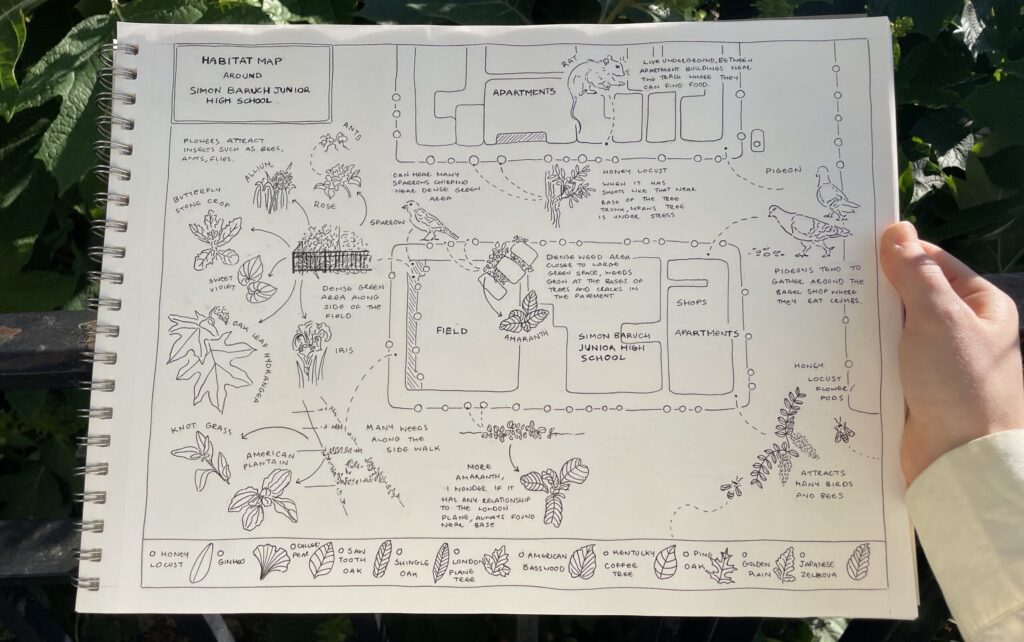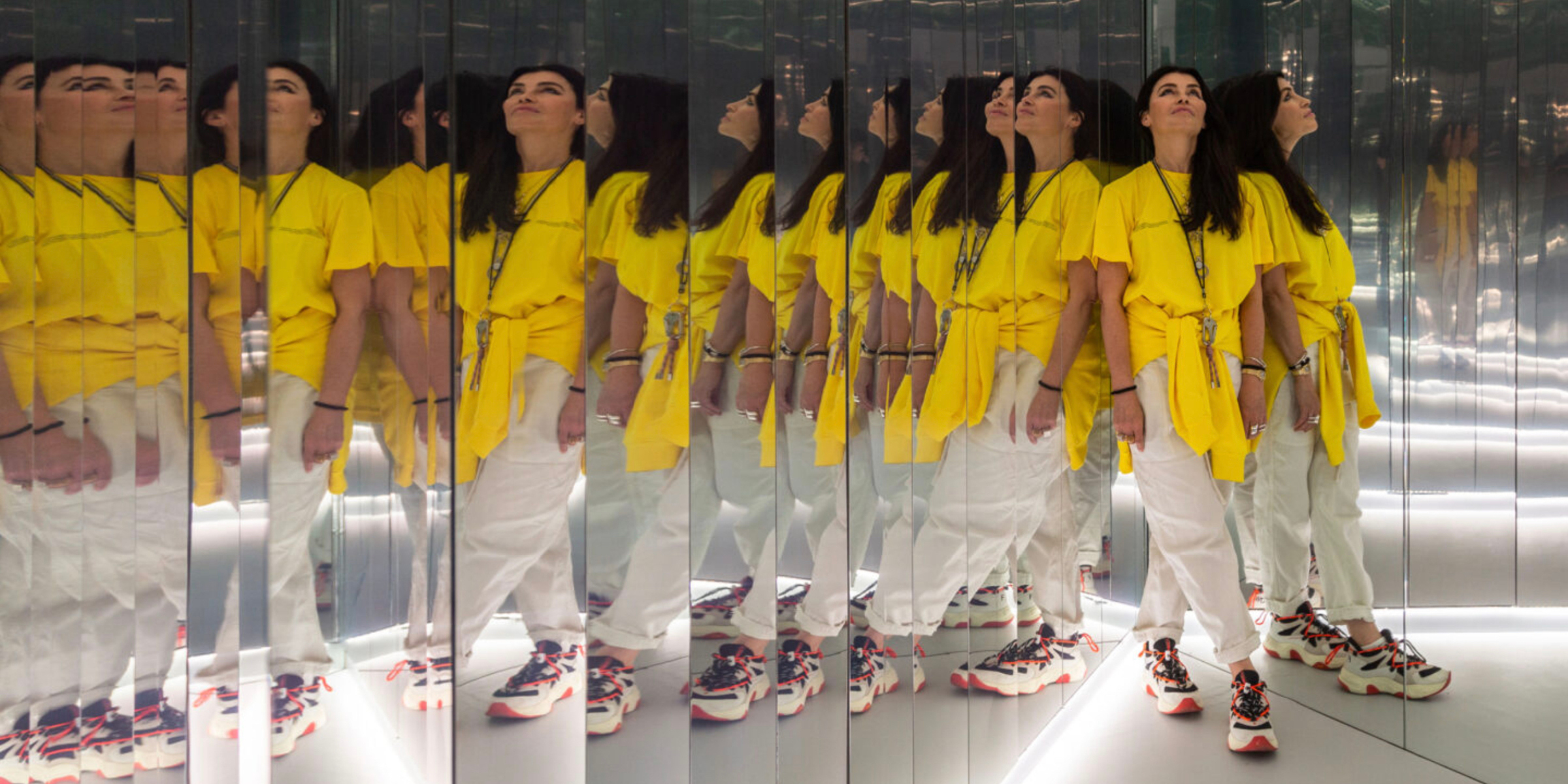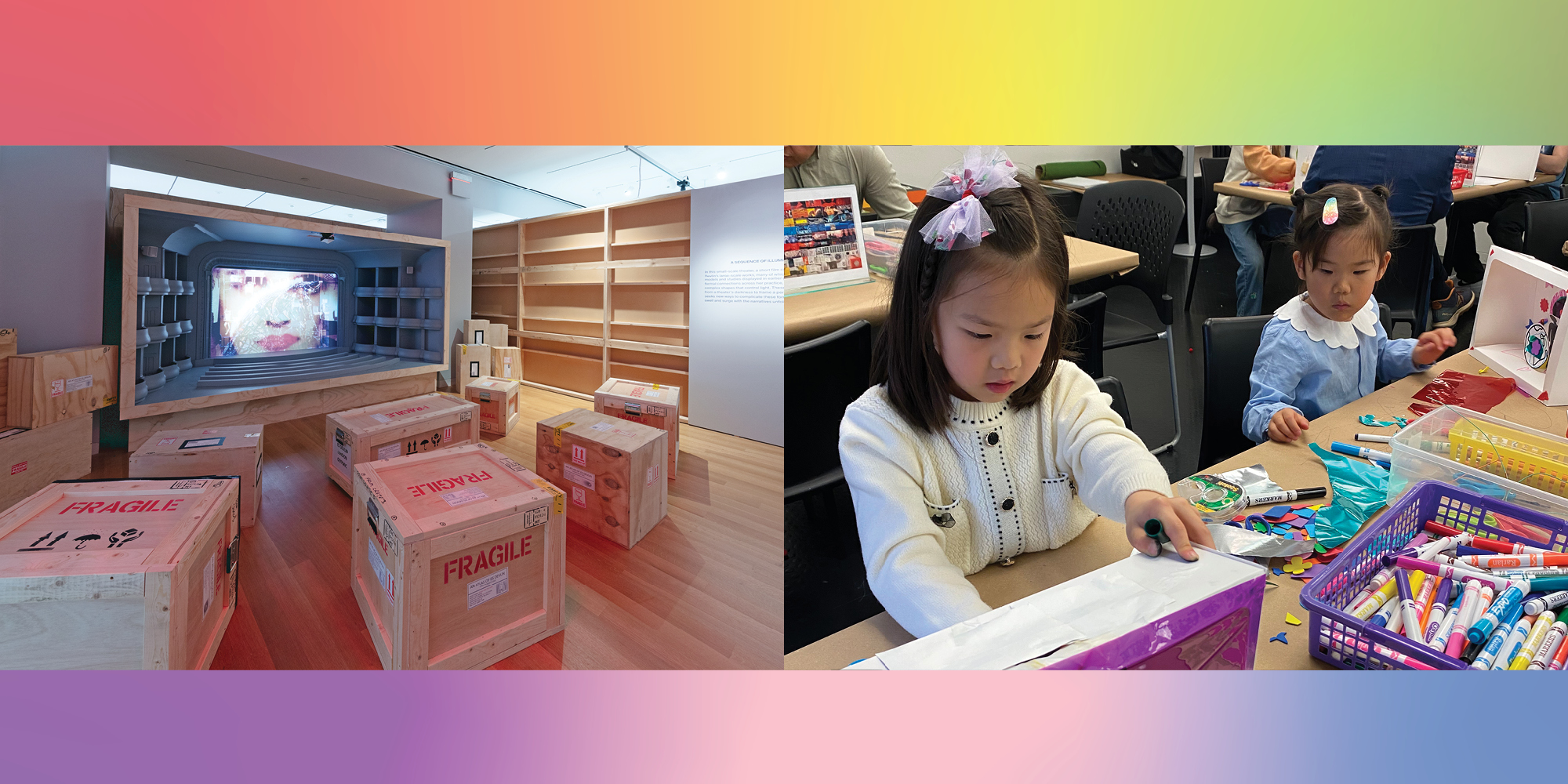June: Perspective Shift

Explore more curriculum themes
June: Perspective Shift
Es Devlin’s public installations often transform viewers into active participants. She believes that part of her role as an artist is to create transformative experiences between audiences and artwork. Several of her sculptural installations address complex issues such as endangered species or languages. In these works, she uses visuals, sound, and performance to deepen how an audience understands and experiences a story. She hopes that these experiences shift audience perspectives and strengthen their connections to each other and to the planet.
In our own creative practices, shifting perspectives can open new ways into thinking about the world and how we experience it. The neighborhoods we live in might feel less familiar if we try to imagine them from the perspective of a pigeon or even a tulip in full bloom. The exercises and materials on this page invite you to explore some new perspectives to foster creative thinking.
Come Home Again

Installation photographs, Come Home Again. Installed 2022, Tate Modern lawn, London, UK; Courtesy of Es Devlin
In September 2022, Es Devlin’s sculptural artwork Come Home Again was installed on the lawn outside Tate Modern in London, England. For the installation, Devlin created a scale replica of the dome of St. Paul’s Cathedral—visible from the lawn just across the River Thames—and filled it with meticulous, large-scale drawings of 243 London animal and plant species most at risk of extinction. Devlin spent four months making these drawings. She described the process as a kind of meditation. She barely left her desk, drawing insects, mammals, fish, birds, amphibians, fungi, and plants from the moment she woke up until she went to sleep. In the installation, a soundscape accompanied the visuals, playing back the names and sounds of the animals during the daytime. At sunset, choirs performing in the sculpture continued a centuries-old ritual of Choral Evensong at St. Paul’s Cathedral and other churches throughout London, combining the sounds of human and non-human voices in a nightly ritual.

Es Devlin, Studies, Come Home Again. Graphite on paper. Installed 2022, Tate Modern lawn, London, UK; Courtesy of Es Devlin
Table of Contents
- Prompts: Quick writing or visual activities
- Exercises: Activities that might ask you to spend a little more time
- Related Reading: Highlights from Cooper Hewitt, Smithsonian Design Library
- Programs: Exhibition tours, lectures, and hands-on workshops for visitors at all age and experience levels
PROMPTS
Have you ever looked at an insect through a magnifying glass? Did it change and expand your perspective on that particular insect, or even all insects? What surprised you? How might your perspective have shifted through examining it in extreme close-up? These prompts are designed to help you observe nature closely. They are geared towards 15 and up, but all are welcome to try them out!
Zooming IN
The British artist, scientist, and engineer Robert Hooke (1635 – 1703) was likely the first person to make it possible for us to explore the world on a microscopic scale. Using a microscope of his own design, Hooke examined insects, plants, and other natural materials and creatures, creating large and highly detailed drawings of them, which he published in his book, Micrographia, in 1635. Hooke’s studies created whole new areas of exploration and research. He even coined the term “cell” to denote the structures of plants and animals, creating an understanding of life on a microscopic level. It’s hard to overestimate the impact of his research, but might his techniques also help us appreciate the world around us in new ways? Let’s explore the microscopic world.
1. Looking Closely
Let’s look at Hooke’s illustration of a louse grasping a strand of hair. In day-to-day life, the louse is a nuisance insect so tiny it’s impossible to study accurately with the naked eye and is sometimes even a challenge to see at all. Through a microscope—and captured here in Hooke’s detailed ink drawing—the louse is shown to be a highly complex creature with many details.
When you examine this drawing, what do you notice about the physiognomy of the louse? Does it change your perspective on this common insect? In what ways? Try zooming in even further to this drawing. Does it make you think of anything, perhaps a monster from a fantasy novel, or even a very precise tool for holding on tight? Identify one small element of Hooke’s drawing and quickly sketch it yourself.
Let’s look at another example from Micrographia, the structure of a feather. How would you describe this image? What does it remind you of—maybe a skeleton, a building under construction, or a woven textile? Imagine what it might it be if it was blown up to the scale of a city or planet. Write down all the possibilities that come to mind and select one to quickly sketch.
2. Exploring your world with new eyes
If you have a simple magnifying glass, or a smart phone with a macro function, you can explore the microscopic world using found objects from your home or community. Take a walk—maybe by mapping your habitat with the exercise below!—and find something that catches your eye. A blade of grass, a feather, a stone—it can be anything at all. Document it as you see it, in words and in quick sketches. The point of this is not to create naturalistic drawings, but to explore your object through close analysis with your eyes and hands. Now use your magnifying device and do the same exercise.

Consider:
- What is new?
- What is unexpected?
- What has shifted your perspective about this object and the world it comes from?
- Does it give you a new appreciation for the natural world that surrounds us all, from remote locations to dense cities?
- Did the exercise of drawing something at a macro or even microscopic scale help you to observe details? What is one thing you would love to explore under a microscope and why?

EXERCISES
Exercises are activities that might ask you to spend a little more time or to gather and play with some additional materials.
Habitat Maps
When we think of our neighborhood, we may think we only share it with other human beings, but we share it with thousands of different organisms and their habitats, from birds in the trees, to weeds that grow between cracks in the pavement, to tiny invisible microorganisms in the soil. This exercise invites you to walk around your local neighborhood and closely observe and record the natural wildlife in your surroundings in a habitat map. Bring a pencil and sketch pad to write and draw your observations.
NEIGHBORHOOD HABITAT MAP
A neighborhood habitat map helps you explore what organisms exist around you. By taking notice of different species in your neighborhood and learning about their characteristics, we can learn how to better live in harmony with biodiversity.
1. Draw a map of your neighborhood
Draw a map of your neighborhood from a bird’s eye perspective, considering how much area to include. Add natural and man-made landmarks such as rivers, buildings, street signs, bus stops, and more.
As you draw your map, consider:
- Creating a legend of symbols that represent repetitive landmarks or specific organisms.
- Creating contrast by using bright or bold colors to highlight wildlife areas and drawing manmade features in black and white.
 2. Fill the map with your discoveries as you walk around the neighborhood.
2. Fill the map with your discoveries as you walk around the neighborhood.
Mark organisms you see and spaces of life ranging from garden beds and trees to areas on the sidewalk where pigeons like to hang out. Think about why life exists in certain places and consider adding this to your map.
As you walk around the neighborhood, consider:
- Observing wildlife from different perspectives, looking towards the sky to the ground beneath your feet.
- Observing wildlife at different scales, from massive trees to small insects you may find if you look closely.
- Why might life exist there? What are the characteristics of that place?
ANIMAL HABITAT MAP
An animal habitat map helps you learn about a specific animal that lives in your neighborhood by trying to view the environment from its perspective.
1. Go on an observation walk.
Take some time to walk around your neighborhood before selecting an animal to focus on. After choosing, spend time observing the species and writing or drawing your observations. What can you learn about the species’ characteristics, habitat, and needs to survive?
Consider:
- What does the animal eat and where does it find food and water?
- What type of shelter does it need? Shelters come in many forms and sizes, from a caterpillar under a leaf to a bird’s nest in a tree.
- How much space does it need? Space can vary from species to species. The habitat space of an ant colony may only be a few square inches to create tunnels and find food, whereas a squirrel may travel up to three to five miles from its territory to find food and water.
- How does the organism travel around your neighborhood? How do man-made features impact how it travels? For example, telephone poles for birds and underground sewage for rats could act as highway systems.
- What other areas around your neighborhood can this animal be found? What does that tell us about its need to survive or its relationship to other organisms?
2. Draw your map
Draw a habitat map from the perspective of the animal. It could be from a bird’s eye perspective or from a low point on the ground that gives a sense of how the animal sees the world.
Consider:
- If the habitat is a large space, it may be helpful to create a legend of symbols.
- Annotate your map and highlight the main components of the habitat the organisms need for survival.
- Include other organisms it has relationships with or even man-made structures.
3. Share with your community.
After you’ve finished making your neighborhood or species habitat map, share it with members of your community. You could make copies of your map to share, or you might hang it on a community notice board, in the doorway of your apartment, or add it to a book sharing box in your local community garden or park.

RELATED READING
FROM Cooper Hewitt, Smithsonian Design Library
Cooper Hewitt, Smithsonian Design Museum’s Library has over 200 artists’ books. These are works of art in book form or inspired by the book. Like zines and posters, artists’ books often call attention to and share new perspectives around certain subjects.
Two recent artists’ book acquisitions feature the pangolin, one of the world’s most illegally trafficked animals. The books were made during the COVID-19 pandemic, when the pangolin was targeted as being the possible origin of the virus. Each artist uses a different approach to correct this false narrative and bring attention to the animal’s endangered status.
Pangolin Pandemic by Gabrielle Cooksey
Gabrielle Cooksey’s Pangolin Pandemic showcases her craftsmanship as a fine book binder, applying traditional techniques like stub binding—which allows each section of the book to open freely and lie perfectly flat—while using unconventional materials like wallpaper and brass to create the pangolin illustrations. Each illustration is paired with an excerpt from a 1348 poem about the bubonic plague by Italian Renaissance poet Francesco Petrarch, connecting the recent pandemic to a historic one.
On the Brink by Carolyn Shattuck
On the Brink features a paper sculpture of a pangolin rising from a flexible accordion binding. The creature appears fragile, surrounded by a chaotic sea of colorful abstractions with scale-shaped cut outs. On the left-hand side, Shattuck includes a paper you can pull down to reveal the “Bogus medicinal cures using pangolin scales”—misinformation that circulated during the pandemic as a cure to COVID-19. On the right, the artist lists many facts about this unusual mammal.
House of Cods, published by Linda Smith and Picnic Press
Another example of an artist book drawing attention to an endangered species is House of Cods, published by Linda Smith and Picnic Press in 1996, which addresses the environmental impact of overfishing. The title plays on pronunciation with a Massachusetts accent (“house of cods” instead of “house of cards”), which is reinforced by the imaginative paper construction and naturalistic fish printed on the book cover. Smith created the colorful fish using a traditional Japanese printing technique called gyotaku, where real fish are used as a “printing plate” to capture the realistic impression and details of the animal.

UPCOMING PROGRAMS
Cooper Hewitt hosts a range of programs—including exhibition tours, lectures, hands-on workshops, and others—for visitors at all age and experience levels.
Learn more about upcoming programs at Cooper Hewitt.

1:30 p.m. to 2:15 p.m. ET
2 E. 91st Street
New York, NY 10128

11:00 a.m. to 4:00 p.m. ET
2 E. 91st Street
New York, NY 10128

1:30 p.m. to 2:15 p.m. ET
2 E. 91st Street
New York, NY 10128


